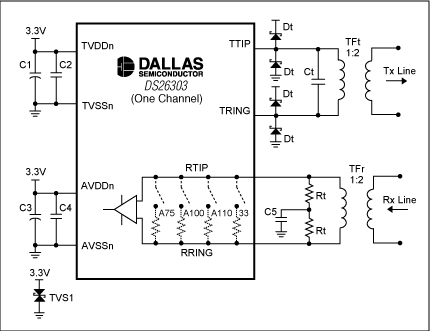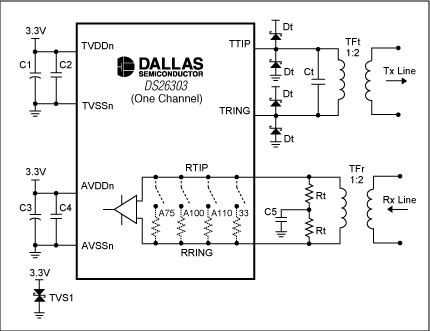摘要:本文比較了DS26303和LXT384的不同,特別是提供了如何在已有的LXT384應用中使用DS26303,詳細闡述了特性區別、寄存器和硬件設計時的考慮。
特性的區別分為三個不同部分:表1為DS26303具備而LXT384不具備的一些特性;表2為LXT384具備而DS26303不具備的一些特性。表3為DS26303和LXT384共有但是在兩個器件上實現不同的特性。
表6到表10為DS26303和LXT384寄存器之間的不同以及DS26303擴展寄存器組提供的附加功能。圖1和表11為在現有的LXT384應用中使用DS26303時需要對器件值所做的細微改變。
表1. DS26303不同于LXT384的特性
表2. LXT384不同于DS26303的特性
表3. DS26303和LXT384共有的特性區別
表4. DS26303 MCLK的選擇范圍
表5. DS26303時鐘A的選擇范圍
表6. DS26303和LXT384的主寄存器組
為了利用DS26303的附加特性和靈活性,必須在所有LXT384應用的源代碼中添加程序。DS26303中的ADDP寄存器的地址是1F (十六進制),這個地址在LXT384中是保留的。ADDP被用作指針來訪問不同的寄存器組。表7為DS26303寄存器組列表和訪問不同的寄存器組時所需要的ADDP值。
表7. DS26303地址指針選擇
表8為二級寄存器組包含的寄存器列表,表9為獨立LIU寄存器組包含的寄存器列表,表10為BERT寄存器組包含的寄存器列表。
表8. DS26303的二級寄存器組
表9. DS26303的獨立LIU寄存器組
表10. DS26303的BERT寄存器組

圖1. LIU前端電路圖
表11. LIU前端值
概述
本文比較了DS26303和LXT384的不同,特別是提供了如何在已有的LXT384應用中使用DS26303。DS26303是一個單3.3V供電的8通道E1/T1/J1短程線路接口單元(LIU)。不需要更改軟件它就可以支持LXT384的功能,并且通過擴展的寄存器組它還能提供附加的特性。不需要改變PCB,DS26303就可以用在現有的LXT384應用中,僅僅需要根據應用改變外圍元器件值。特性的區別分為三個不同部分:表1為DS26303具備而LXT384不具備的一些特性;表2為LXT384具備而DS26303不具備的一些特性。表3為DS26303和LXT384共有但是在兩個器件上實現不同的特性。
表6到表10為DS26303和LXT384寄存器之間的不同以及DS26303擴展寄存器組提供的附加功能。圖1和表11為在現有的LXT384應用中使用DS26303時需要對器件值所做的細微改變。
表1. DS26303不同于LXT384的特性
| DS26303 | LXT384 |
| Programmable options to clear interrupt status on write or read. Clear on read is default. | Not supported. |
Individual channel control for jitter attenuator:
|
All channels have global control. |
| Internal software-selectable transmit and receive side termination for 100Ω T1 twisted-pair, 110Ω J1 twisted-pair, 120Ω E1 twisted–pair, and 75Ω E1 coaxial applications. | Not supported. |
| In HPS mode, the transmitter output and the internal impedance of the receiver can be turned off with only the OE pin. | Requires that both receivers use the same front-end termination. |
| Built-in BERT tester for diagnostics. | Not supported. |
| Individual channel control for: | All channels have global control. |
| Individual channel-line violation detection. | Not supported. |
| Flexible MCLK See Table 4 for available input frequencies. |
Not supported. |
| Programmable TECLK output pin (1.544MHz or 2.048MHz) | Not supported. |
| Programmable CLKA output pin See Table 5 for available output frequencies. | Not supported. |
| Flexible interrupt pin | Not supported. |
表2. LXT384不同于DS26303的特性
| DS26303 | LXT384 |
| Uses single optimal value. | Capability to select the jitter attenuator bandwidth. |
| — | Analog JTAG |
| MLCK Pin Functionality The DS26303 and LXT384 both require MCLK to for data with clock recovery as well as AIS detection. The MCLK pin of the LXT384 provides additional functionality not present in the DS26303. LXT384 MCLK held high.
| |
表3. DS26303和LXT384共有的特性區別
| DS26303 | LXT384 |
| 3.3V LIU power only, 5V not provided. | 5V LIU power. |
| Non-mux Intel? write address to WRB rising-edge setup time is 17ns. | Non-mux Intel write address to WRB rising-edge setup time is 6ns. |
| Expects non-mux Intel read address to be valid when RDB is active. | Non-mux Intel read address to RDB rising-edge setup time is 6ns. This might be an error in datasheet because data is out before this setup time. |
| Inactive RDY to tri-state delay time 12ns (max). | Inactive RDY to tri-state delay time 3ns (max). |
| Clears the interrupt pin when reading or writing the interrupt status. | Clears interrupt pin when reading the status register. |
| Jitter attenuator FIFO depths of 32 bits or 128 bits. | Jitter attenuator FIFO depths of 32 bits or 64 bits. |
Individual channel control for jitter attenuator:
|
All channels have global control. |
表4. DS26303 MCLK的選擇范圍
| PLLE | MPS1, MPS0 | MCLK MHz (±50ppm) | FREQS | T1 or E1 Mode |
| 0 | xx | 1.544 | x | T1 |
| 0 | xx | 2.048 | x | E1 |
| 1 | 00 | 1.544 | 1 | T1/J1 or E1 |
| 1 | 01 | 3.088 | 1 | T1/J1 or E1 |
| 1 | 10 | 6.176 | 1 | T1/J1 or E1 |
| 1 | 11 | 12.352 | 1 | T1/J1 or E1 |
| 1 | 00 | 2.048 | 0 | T1/J1 or E1 |
| 1 | 01 | 4.096 | 0 | T1/J1 or E1 |
| 1 | 10 | 8.192 | 0 | T1/J1 or E1 |
| 1 | 11 | 16.384 | 0 | T1/J1 or E1 |
表5. DS26303時鐘A的選擇范圍
| CLKA3 to CLKA0 | MCLK (Hz) |
| 0000 | 2.048M |
| 0001 | 4.096M |
| 0010 | 8.192M |
| 0011 | 16.384M |
| 0100 | 1.544M |
| 0101 | 3.088M |
| 0110 | 6.176M |
| 0111 | 12.352M |
| 1000 | 1.536M |
| 1001 | 3.072M |
| 1010 | 6.144M |
| 1011 | 12.288M |
| 1100 | 32k |
| 1101 | 64k |
| 1110 | 128k |
| 1111 | 256k |
寄存器的考慮事項
DS26303包括四個主要的寄存器組。- 主寄存器組(DS26303和LXT384)
- 二級寄存器組(DS26303獨有)
- 獨立LIU寄存器組(DS26303獨有)
- BERT寄存器組(DS26303獨有)
表6. DS26303和LXT384的主寄存器組
| Address (Hex) | DS26303 | LXT384 |
| 00–15 | Primary Registers | Registers |
| 16–1E | Reserved | Reserved |
| 1F | ADDP (Address pointer for additional register banks). This register must be set to point to the desired register bank. 00h) Primary Bank AAh) Secondary Bank 01h) Individual LIU Bank 02h) BERT Bank |
Reserved |
為了利用DS26303的附加特性和靈活性,必須在所有LXT384應用的源代碼中添加程序。DS26303中的ADDP寄存器的地址是1F (十六進制),這個地址在LXT384中是保留的。ADDP被用作指針來訪問不同的寄存器組。表7為DS26303寄存器組列表和訪問不同的寄存器組時所需要的ADDP值。
表7. DS26303地址指針選擇
| ADDP7 to ADDP0 (Hex) | Bank Name |
| 00 | Primary Bank |
| AA | Secondary Bank |
| 01 | Individual LIU Bank |
| 02 | BERT Bank |
表8為二級寄存器組包含的寄存器列表,表9為獨立LIU寄存器組包含的寄存器列表,表10為BERT寄存器組包含的寄存器列表。
表8. DS26303的二級寄存器組
| Address (Hex) | Register Name |
| 00 | Single-Rail Mode Select |
| 01 | Line-Code Selection |
| 02 | Not used |
| 03 | Receiver Power-Down Enable |
| 04 | Transmitter Power-Down Enable |
| 05 | Excessive Zero-Detect Enable |
| 06 | Code-Violation-Detect Enable Bar |
| 07–1E | Not used |
| 1F | Set to AAh for access to Secondary Register Bank |
表9. DS26303的獨立LIU寄存器組
| Address (Hex) | Register Name |
| 00 | Individual JA Enable |
| 01 | Individual JA Position Select |
| 02 | Individual JA FIFO Depth Select |
| 03 | Individual JA FIFO Limit Trip |
| 04 | Individual Short-Circuit-Protection Disable |
| 05 | Individual AIS Select |
| 06 | Master Clock Select |
| 07 | Global-Management Register |
| 08–0F | Reserved |
| 10 | Bit-Error-Rate Tester Control Register |
| 12 | Line-Violation Detect Status |
| 13 | Receive Clock Invert |
| 14 | Transmit Clock Invert |
| 15 | Clock-Control Register |
| 16 | RCLK Disable Upon LOS Register |
| 1E | Global-Interrupt Status Control |
| 1F | Set to 01h for access to Individual LIU Register Bank |
表10. DS26303的BERT寄存器組
| Address (Hex) | Register Name |
| 00 | BERT Control Register |
| 01 | Reserved |
| 02 | BERT Pattern Configuration 1 |
| 03 | BERT Pattern Configuration 2 |
| 04 | BERT Seed/Pattern 1 |
| 05 | BERT Seed/Pattern 2 |
| 06 | BERT Seed/Pattern 3 |
| 07 | BERT Seed/Pattern 4 |
| 08 | Transmit-Error Insertion Control |
| 09–0A | Reserved |
| 0C | BERT Status Register |
| 0D | Reserved |
| 0E | BERT Status Register Latched |
| 10 | BERT Status Register Interrupt Enable |
| 11–13 | Reserved |
| 14 | Receive Bit-Error Count Register 1 |
| 15 | Receive Bit-Error Count Register 2 |
| 16 | Receive Bit-Error Count Register 3 |
| 17 | Receive Bit-Error Count Register 4 |
| 18 | Receive Bit Count Register 1 |
| 19 | Receive Bit Count Register 2 |
| 1A | Receive Bit Count Register 3 |
| 1B | Receive Bit Count Register 4 |
| 1C–1E | Reserved |
| 1F | Set to 02h for access to BERT Register Bank |
硬件考慮事項
不用改變PCB就可以用DS26303替換現有應用中的LXT384。需要做的是根據目標應用改變外部器件值。圖1為DS26303推薦的網絡端接電路,表11為DS26303正確端接時需要的器件值。發送器
LXT384要求發送端電阻串聯接入TTIP和TRING輸出,建議這些電阻應該為0Ω (T1 3.3V模式),11Ω (E1 75Ω同軸)或者11Ω (E1 120Ω雙絞線)。DS26303不要求電阻,所以所有模式中的電阻都應該為0Ω。當禁止脈沖成形時,LXT384要求有一個DC隔離電容。DS26303不要求DC隔離電容,因此,如果現有LXT384應用的PCB電路中有電容可以用一個0Ω的電阻替換。接收器
在接收側,LXT384要求端接阻抗為12.4Ω (T1 3.3V模式),9.31Ω (E1 75Ω同軸)或者15Ω (E1 120Ω雙絞線)。當使用外部阻抗模式時,DS26303的所有情況都要求用15Ω端接電阻;當使用DS26303的軟件選取阻抗匹配模式,不需要任何電阻。LXT384要求使用1kΩ電阻同RTIP和RRING管腳串聯。如果DS26303采用軟件選取端接/阻抗匹配模式,這些1kΩ的電阻可以用0Ω電阻代替。
圖1. LIU前端電路圖
表11. LIU前端值
| Mode | Component | 75 Coax | 120 Twisted Pair | 100/110 Twisted Pair |
| Tx Capacitance | Ct | 560pF (typ). Adjust for board parasitics for optimal return loss. | ||
| Tx Protection | Dt | International Rectifier: 11DQ04 or 10BQ060 Motorola: MBR0540T1 | ||
| Rx Transformer 1:2 | TFr | Pulse: T1124 (0°C to +70°C) | ||
| Tx Transformer 1:2 | TFt | Pulse: T1114 (-40°C to +85°C) | ||
| Tx Decoupling (ATVDD) | C1 | Common decoupling for all eight channels is 68μF. | ||
| Tx Decoupling (ATVDD) | C2 | Recommended decoupling per channel is 0.1μF. | ||
| Rx Decoupling (AVDDn) | C3 | Common decoupling for all eight channels is 68μF. | ||
| Rx Decoupling (AVDDn) | C4 | Common decoupling for all eight channels is 0.1μF. | ||
| Rx Termination | C5 | When in external impedance mode, Rx capacitance for all eight channels is 0.1μF. Do not populate if using internal impedance mode. | ||
| Rx Termination | Rt | When in external impedance mode, the two resistors for all modes is 15.0Ω ±1%. Do not populate if using internal impedance mode. | ||
| Voltage Protection | TVS1 | SGS-Thomson: SMLVT 3V3 (3.3V transient suppressor) | ||
 電子發燒友App
電子發燒友App




































評論